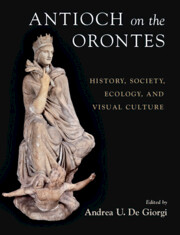Book contents
- Antioch on the Orontes
- Antioch on the Orontes
- Copyright page
- Dedication
- Contents
- Plates
- Figures
- Tables
- Contributors
- Abbreviations
- Antioch on the Orontes
- Part I Beginnings
- Part II The Making of a Capital
- Part III The People of Antioch
- Part IV Religion
- Chapter 22 The First Christians of Antioch
- Chapter 23 Christian Antioch
- Chapter 24 Julian in Antioch
- Chapter 25 The Churches of Antioch in the Life of the City
- Chapter 26 Who Is Jesus Christ?
- Part V Crises and Resilience
- Index
- Plate Section
- References
Chapter 23 - Christian Antioch
A Portrait of the Bishops of the Local Church
from Part IV - Religion
Published online by Cambridge University Press: 06 June 2024
- Antioch on the Orontes
- Antioch on the Orontes
- Copyright page
- Dedication
- Contents
- Plates
- Figures
- Tables
- Contributors
- Abbreviations
- Antioch on the Orontes
- Part I Beginnings
- Part II The Making of a Capital
- Part III The People of Antioch
- Part IV Religion
- Chapter 22 The First Christians of Antioch
- Chapter 23 Christian Antioch
- Chapter 24 Julian in Antioch
- Chapter 25 The Churches of Antioch in the Life of the City
- Chapter 26 Who Is Jesus Christ?
- Part V Crises and Resilience
- Index
- Plate Section
- References
Summary
This chapter engages with Antioch’s church, highlighting pastoral figures and their role in leading the local community.
- Type
- Chapter
- Information
- Antioch on the OrontesHistory, Society, Ecology, and Visual Culture, pp. 371 - 390Publisher: Cambridge University PressPrint publication year: 2024

